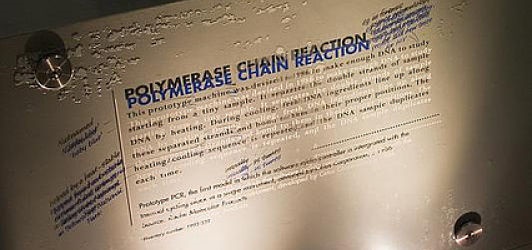Loop-mediated Isothermal amplification (LAMP), is an emerging technology that allows DNA amplification at a constant temperature. The key to this principle is the use of a DNA polymerase that possesses strand displacement activity. As a result of this property there is no need for heat denaturation of double stranded DNA in order to allow primer annealing and subsequent amplicon elongation.
How LAMP Works
Through the use of 4 different primers specifically designed to recognize 6 distinct regions on the target gene, the reaction process proceeds at a constant temperature using strand displacement reaction. Amplification and detection of a gene can be completed in a single step, by incubating the mixture of samples, primers, DNA polymerase with strand displacement activity and substrates at a constant temperature (about 65°C).
The reaction is much faster (15-60 minutes) than conventional PCR. As a result there is no need to use a thermocycler.
As there is no requirement for different temperature cycles like in conventional PCR (necessary for DNA denaturation, primer annealing and elongation) the DNA amplification process is quicker, simpler and cheaper than conventional PCR. In theory the entire process can be carried out in a water bath.
As the reaction releases magnesium pyrophosphate (reaction by-product) in proportion to the amount of amplified product, the detection can be done at end point at naked eye, especially for larger reaction volumes. On the other hand the turbidity also can be recorded at 400 nm using one turbidimeter.
Using intercalating dyes as SYBR Green ™, the sensitivity of the detection method also can be increased allowing for real-time detection and target quantification.
As 4 primers are used for detecting 6 distinct regions LAMP is able to detect the target gene more specifically than conventional PCR and qPCR.
Additionally, amplification can be done with RNA templates following the same procedure as with DNA templates, simply through the addition of reverse transcriptase.
Since some enzymes used in LAMP are less sensitive to inhibition than Taq polymerase they can work with minimally processed samples. This fact enables field applications or simplest workflows in some case.
Disadvantages of LAMP
However this technology has several intrinsic disadvantages as restricted availability of reagents and instruments, no multiplex capability and limitations related with primer design.
This technology, does not allow the inclusion of an internal PCR inhibition control (IC) and for this reason it is sometimes necessary to perform the reactions in duplicate, one reaction for the target and the other one for the IC. As each initial target generates one unique PCR product in form of large DNA chain, LAMP is less versatile than PCR.
Primer design requirements constrains target sites selection and this fact can limit the procedure resolution or specificity. Additionally, it needs specific software.
Since the final product is a large fragment, is not useful for cloning or innumerable other molecular biology applications enabled by PCR.
Despite these limitations, this technology is widely cited throughout the literature and a number of companies offer solutions based on this technology. The simplicity of the method combined with the sensibility and specificity of PCR puts LAMP technology in a very good position for future development. Furthermore, for the same reasons LAMP has potential applications for clinical diagnosis as well as surveillance of infectious diseases in developing countries without requiring sophisticated equipment or skilled personnel
Several successful examples of quick and easy analytical solutions exist based on this technology. One example is in food industry with the 3M Molecular Detection System. In the clinical environment the trend is to develop easy solutions for early diagnosis in the outpatient clinics or medical centers (point of care diagnostics) based on chips or cartridges for single use that could be done with a minimum training.
Recommended Reading:
Parida M, Sannarangaiah S, Dash PK, Rao PV, Morita K. (2008) Loop mediated isothermal amplification (LAMP): a new generation of innovative gene amplification technique; perspectives in clinical diagnosis of infectious diseases. Rev Med Virol. 18:407–21. doi: 10.1002/rmv.593.
Eiken Genome Site. The principle of LAMP method.
Yi Hyoseok. LAMP. (Youtube video).






